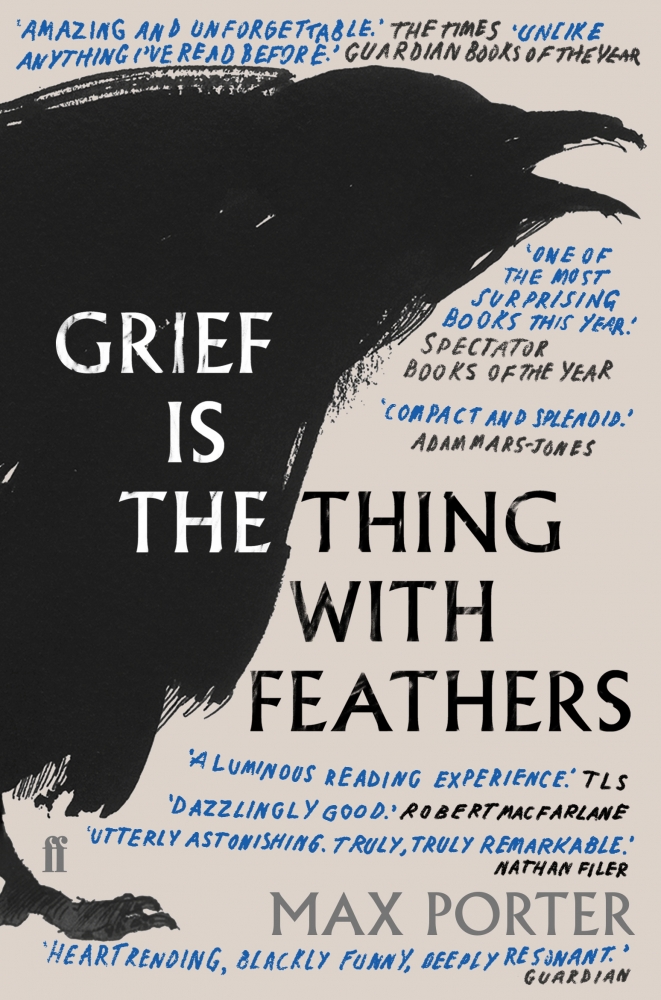Grief is the Thing with Feathers
By Max Porter

Blurb
Here he is, husband and father, scruffy romantic, a shambolic scholar—a man adrift in the wake of his wife’s sudden, accidental death. And there are his two sons, who, like him, struggle in their London flat to face the unbearable sadness that has engulfed them. The father imagines a future of well-meaning visitors and emptiness while the boys wander, savage and unsupervised.
In this moment of violent despair they are visited by Crow—antagonist, trickster, goad, protector, therapist, and babysitter. This self-described “sentimental bird,†at once wild and tender, who “finds humans dull except in grief,†threatens to stay with the wounded family until they no longer need him. As weeks turn to months and the pain of loss lessens with the balm of memories, Crow’s efforts are rewarded and the little unit of three begins to recover: Dad resumes his book about the poet Ted Hughes; the boys get on with it, grow up.
Our Review
Grief is the thing with feathers is the tale of two young boys and their father trying to deal with the aftermath of their mother’s death. Their father is barely coping during the day and in the evenings is turning to alcohol to help him deal with the profound loss of his wife.
It is here that we are introduced to Crow. Crow is many things to the grieving family; a macabre spectre at the feast, a Mary Poppins type figure, a nuisance and a friend.
The book is narrated by ‘Dad’, ‘Boys’ and ‘Crow’ and the layout changes constantly throughout the book but not in an annoying way. As well as the ever changing layout I also liked the way each part of the book had a single black feather underneath the heading.
The book begins with the following words:
“There’s a feather on my pillow.
Pillows are made of feathers, go to sleep.
It’s a big, black feather.
Come and sleep in my bed.
There’s a feather on your pillow too.
Let’s leave the feathers where they are and sleep on the floor.”
It is surprising how such a small book can so accurately describe the range of emotions people can experience while grieving and some of the obstacles they can face.
Four or five days after her death Dad is struggling with the early stages of grief: Grief felt fourth-dimensional, abstract, faintly familiar. I was cold.
Peppered throughout the book are little descriptions of the deceased wife and mother, We were always over-analytical, cynical, probably disloyal, puzzled. Dinner party post-mortem bitches with lurid intentions. Hypocrites, friends.
The Crow arrives to aid them with dealing with their grief and states, I won’t leave until you don’t need me anymore.
The Crow is a somewhat sinister creature but among his many other designs he plays the role of grief counsellor quite well. He is also the outsider through which we are able to view the extent of their grief. He woke up and didn’t see me against the blackness of his trauma.
The author does a very good job of describing the boys reaction when they learn of their mother’s death:
“Where are the fire engines? Where is the noise and clamour of an event like this? Where are the strangers going out of the way to help, screaming, flinging bits of emergency glow – in – the-dark equipment at us to try and settle us and save us?”
One of the saddest bits of is when Dad realises the things he will forget and won’t see again:
“She won’t ever use (make-up, turmeric, hairbrush, thesaurus.)
She will never finish (Patricia Highsmith novel, peanut butter, lip balm.)
And I will never shop for green vintage classics for her birthday.
I will stop finding her hairs.
I will stop hearing her breathing.”
One of the main things I enjoyed about the book is that the author doesn’t try to suggest Dad is over his grief at any stage. Moving on, as a concept, is for stupid people, because any sensible person knows grief is a long-term project. I refuse to rush.
Our Final Rating...
Read & Shared 80 Times.



Get In Touch
Please feel free to leave a comment to this book review below. Or even leave your own review if you like.
If you run a blog and/or have posted a review to this book, a Q & A or general author interview online you can always add a trackback to it here and following moderation we'll add a link to it below.